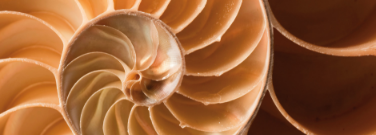Nature’s Patterns: They’re All Around Us

By Kymberly Perry
Have you ever looked at the center of a sunflower and been mesmerized by its intricate patterns? Or skipped a rock on a smooth-as-glass lake and watched the ripples flow out in a series of concentric circles? If so, you’re witnessing patterns in nature. It’s likely that you’ve even heard of some of these concepts in your math classes.
Understanding Patterns
For centuries, philosophers have wondered about the delicate patterns that appear in nature. Leonardo Bonacci, a 13th-century mathematician, sought to study these natural occurrences. His research led to what’s known as the Fibonacci sequence, a set of increasing numbers that add together to equal the next number in the series. This results in a never-ending sequence: 1, 1, 2, 3, 5, 8, 13, 21, 34, 55, 89, 144, and so on. The number of petals on a flower and branches on a tree are just two examples of this.
Bonacci’s work also led to a mathematical relationship known as the golden ratio. The value of this ratio is approximately 1.618 and is determined by dividing each number in the Fibonacci sequence by the number that comes before it. This pattern is found in the spiral patterns of snail shells.
Take a Closer Look at Sunflowers
From a distance, sunflowers seem simple, but they’re a primary example of the Fibonacci sequence. If you take the time to count a sunflower’s seeds, you’ll find evidence of the Fibonacci sequence. But plants don’t always showcase these sequences perfectly. A study was published in Royal Society Open Science stating that of the sunflowers examined, one in five lacked this common pattern.
Find Fractals in Ferns
Ferns represent yet another mathematical mystery—fractals, or patterns that repeat indefinitely but at different scales. Michael Barnsley, a mathematician based in the United Kingdom, developed a formula that can be used to build a graphic representation of a fern that’s mathematically accurate. Other examples of fractals in nature include pinecones and succulents.
Spot Spirals in Shells
Spirals, or curved patterns that begin at a central point and move outward, are commonly found in nature, too. They’re most notably seen in shells. The golden spiral, which is based on the previously described golden ratio, can be observed via the arrangement of some flower petals. And once again, this naturally occurring pattern is rooted in mathematics.
Observe in the Outdoors
Although there are many examples of patterns in nature, there are some that simply don’t follow the rules. That’s because nature isn’t always predictable, at least not mathematically—but that’s where science steps in.
Flora and fauna will always strike a balance between the amount of energy they have available and the patterns they’re destined to create to achieve the best outcome. Sometimes this results in a perfect pattern and sometimes it results in one of nature’s unpredictable surprises.
Discussion Questions
- Take a short walk outside. What patterns do you see in nature?
- List a few other ways that math and science work together to help us understand the world.